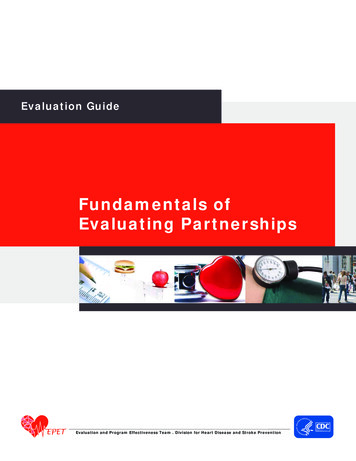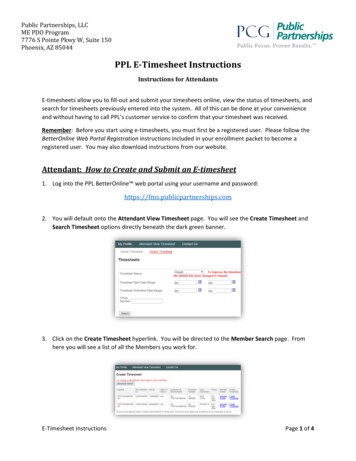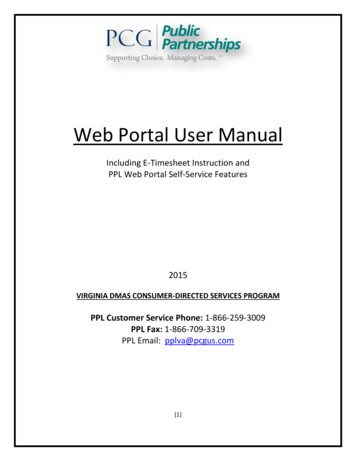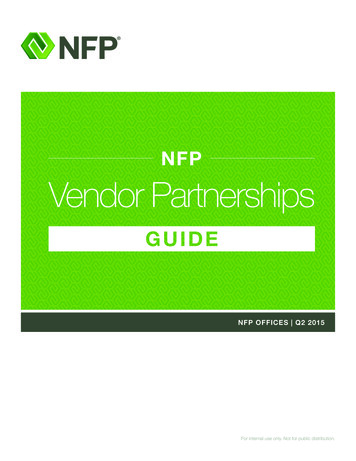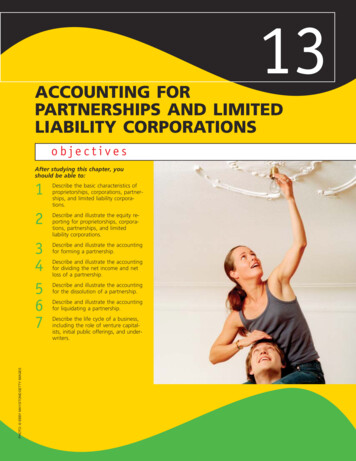
Transcription
13ACCOUNTING FORPARTNERSHIPS AND LIMITEDLIABILITY CORPORATIONSobjectivesPHOTO: EBBY MAY/STONE/GETTY IMAGESAfter studying this chapter, youshould be able to:1Describe the basic characteristics ofproprietorships, corporations, partnerships, and limited liability corporations.2Describe and illustrate the equity reporting for proprietorships, corporations, partnerships, and limitedliability corporations.34567Describe and illustrate the accountingfor forming a partnership.Describe and illustrate the accountingfor dividing the net income and netloss of a partnership.Describe and illustrate the accountingfor the dissolution of a partnership.Describe and illustrate the accountingfor liquidating a partnership.Describe the life cycle of a business,including the role of venture capitalists, initial public offerings, and underwriters.
If you were to start up any type of business, you would want to separate the business’s affairs from your personal affairs. Keeping business transactions separate frompersonal transactions aids business analysis and simplifies tax reporting. For example,if you provided freelance photography services, you would want to keep a businesschecking account for depositing receipts for services rendered and writing checks forexpenses. At the end of the year, you would have a basis for determining the earnings from your business and the information necessary for completing your tax return. In this case, forming the business would be as simple as establishing a nameand a separate checking account. As a business becomes more complex, the form ofthe business entity becomes an important consideration. The entity form has an impact on the owners’ legal liability, taxation, and the ability to raise capital. The fourmajor forms of business entities that we will discuss in this chapter are the proprietorship, corporation, partnership, and limited liability corporation.A lternate Forms of Business Entitiesobjective1Describe the basic characteristics of proprietorships, corporations, partnerships, andlimited liability corporations.A variety of legal forms exist for forming and operating a business. The four mostcommon legal forms are proprietorships, corporations, partnerships, and limited liability corporations. In this section, we describe the characteristics of each of thesebusiness entities.ProprietorshipsAs we discussed in Chapter 1, a proprietorship is a business enterprise owned bya single individual. Internal Revenue Service (IRS) data indicate that proprietorshipscomprise 70% of the business tax returns filed but only 5% of all business revenues.This statistic suggests that proprietorships, although numerous, consist mostly ofsmall businesses. The most common type of proprietorships are professional serviceproviders, such as lawyers, architects, realtors, and physicians.A proprietorship is simple to form. Indeed, you may already be a proprietor. Forexample, a person providing child-care services for friends of the family is a proprietor. There are no legal restrictions or forms to file in forming a proprietorship.The ease of forming a proprietorship is one of its main advantages. In addition, theindividual owner can usually make business decisions without consulting others.This ability to be one’s own boss is a major reason why many individuals organizetheir businesses as proprietorships.A proprietorship is a separate entity for accounting purposes, and when the ownerdies or retires, the proprietorship ceases to exist. For federal income tax purposes,however, the proprietorship is not treated as a separate taxable entity. The incomeor loss is said to “pass through” to the owner’s individual income tax return.1 Thus,the income from a proprietorship is taxed only at the individual level.A primary disadvantage of a proprietorship is the difficulty in raising large amountsof capital. Investment in the business is limited to the amounts that the owner canprovide from personal resources, plus any additional amounts that can be raisedthrough borrowing. In addition, the owner is personally liable for any debts or legalclaims against the business. In other words, if the business fails, creditors have rightsto the personal assets of the owner, regardless of the amount of the owner’s actualinvestment in the enterprise.CorporationsAs we discussed in Chapter 12, the major benefits of the corporate form are its ability to provide limited liability to its owners and its potential for raising large amounts1Theproprietor’s statement of income is included on Schedule C of the individual 1040 tax return.
Chapter 13 Accounting for Partnerships and Limited Liability Corporations519of capital through issuing stock. For these reasons, most large businesses use thecorporate form of entity.However, corporations also have disadvantages. Forming a corporation requireslegal filings to and approvals by state regulatory agencies. In addition, corporationsare more complex to manage and must be operated in accordance with the corporate bylaws. Corporations are taxed as a separate entity. Thus, when earnings aredistributed to shareholders in the form of dividends, they are also taxed again atthe individual level.To avoid the double taxation of dividends, a business may organize as a SubchapterS Corporation. Under an S corporation, the IRS allows income to pass through thecorporation to the individual stockholders without the corporation having to pay taxeson the income. However, the S corporation has a number of legal limitations, including a limitation on the number of stockholders.2 In recent years, the S corporation hasbecome less popular due to the emergence of the limited liability corporation and itsmany advantages, which we will discuss later in this chapter.INTEGRITY IN BUSINESSTHE TEMPTATION OF COMPENSATIONA n owner/manager of a corporation can be taxed on income at the corporate level and again at the individuallevel for dividends. In contrast, compensation is a taxdeductible expense for business purposes and thereforeis taxed only at the individual level. An owner/managerI’m an agriculturalcooperative foundedin 1930 and ownedby more than 900growers in the United States andCanada. Most of my products arebased on a fruit grown primarilyin Wisconsin and Massachusettsthat’s commonly harvested in largebeds of water. In 1995, I introduced dried Craisins. I’m the No. 1brand of canned and bottled juicedrinks in America and my offerings are sold in nearly 50 countriesaround the world. I’m populararound the holidays. My annualsales top 1 billion, and my competitors include Northland, Tropicana, and the National GrapeCooperative. Who am I? (Go topage 543 for answer.)might be tempted to pay himself or herself “compensation” rather than dividends. However, the IRS requires thatcompensation not exceed the fair value of the services delivered to the company. Using compensation to subvertthe double taxation of dividends is considered fraudulent.PartnershipsA partnership is an association of two or more persons who own and manage abusiness for profit.3 Partnerships have several characteristics with accounting implications.A partnership has a limited life. A partnership dissolves whenever a partner ceasesto be a member of the firm. For example, a partnership is dissolved if a partner withdraws due to bankruptcy, incapacity, or death. Likewise, admitting a new partner dissolves the old partnership. When a partnership is dissolved, the remaining partnersmust form a new partnership if operations of the business are to continue.In most partnerships, the partners have unlimited liability. That is, each partner is individually liable to creditors for debts incurred by the partnership. Thus, ifa partnership becomes insolvent, the partners must contribute sufficient personalassets to settle the debts of the partnership.Partners have co-ownership of partnership property. The property investedin a partnership by a partner becomes the joint property of all the partners. Whena partnership is dissolved, the partners’ claims against the assets are measured bythe amount of the balances in their capital accounts.Another characteristic of a partnership is mutual agency. This means that eachpartner is an agent of the partnership. The acts of each partner bind the entire partnership and become the obligations of all partners. For example, any partner canenter into a contract on behalf of all the members of the partnership. This is whypartnerships should be formed only with people you trust.An important right of partners is participation in income of the partnership. Netincome and net loss are distributed among the partners according to their agreement.2Presently,3Thethe law limits S corporations to 75 stockholders, who must be natural persons (not other business entities).definition of a partnership is included in the Uniform Partnership Act, which has been adopted by most states.
520Chapter 13 Accounting for Partnerships and Limited Liability CorporationsA partnership, like a proprietorship, is a nontaxable entity and thusdoes not pay federal income taxes. However, revenue and expense andA partnership is a nontaxableother results of partnership operations must be reported annually to theentity that has a limited lifeInternal Revenue Service. The partners must, in turn, report their share ofpartnership income on their personal tax returns.and unlimited liability, and itA partnership is created by a contract, known as the partnership agreeis bound by the actions ofment or articles of partnership. It should include statements regardingsuch matters as amounts to be invested, limits on withdrawals, distributionseach partner.of income and losses, and admission and withdrawal of partners.A variant of the regular partnership is a limited partnership. A limitedpartnership is a unique legal form that allows partners who are not involvedin the operations of the partnership to retain limited liability. In such a form, at leastone general partner must operate the partnership and retain unlimited liability. Theremaining partners are considered limited partners.The partnership form is less widely used than the proprietorship and corporateforms. For many business purposes, however, the advantages of the partnershipform are greater than its disadvantages.A partnership is relatively easy and inexpensive to organize, requiring only anagreement between two or more persons. A partnership has the advantage of bringing together more capital, managerial skills, and experience than does a proprietorship. Since a partnership is a nontaxable entity, the combined income taxes paidby the individual partners may be lower than the income taxes that would be paidby a corporation, which is a taxable entity.A major disadvantage of the partnership is the unlimited liability feature for partners. Other disadvantages of a partnership are that its life is limited, and one partnercan bind the partnership to contracts. Also, raising large amounts of capital is moredifficult for a partnership than for a corporation. To overcome these limitations, otherhybrid forms of organization, such as limited liability corporations (LLCs), have beenreplacing partnerships as a means of organization.Limited Liability CorporationsCompanies commonly use partnerships and LLCs in forming jointventures. Joint ventures are usedto diversify risk or expand expertise in operating identifiable businesses or projects. For example,Viacom Inc. uses regionallyplaced joint venture partners tobroadcast MTV, VH1, Nickelodeon,and TV Land around the world.Viacom’s joint venture partnersbring local customs, language, andculture to the broadcast offerings.A limited liability corporation (LLC)4 is a relatively new business entity form thatcombines the advantages of the corporate and partnership forms. Many features ofa partnership are retained in an LLC. The owners of an LLC are termed “members”rather than “partners.” The members must create an operating agreement, whichis similar to a partnership agreement. For example, the operating agreement normally indicates how income is to be distributed to the members. Thus, unlike a corporation, income need not be distributed according to the number of shares ownedby each member. Instead, income might be distributed according to the amount oftime each member devotes to the business.For tax purposes, an LLC may elect to be treated as a partnership. In this way,income passes through the LLC and is taxed on the individual members’ tax returns.5Thus, the LLC may avoid the double taxation characterized by the corporate form.Unless specified in the operating agreement, LLCs have a limited life and mustdissolve when a member withdraws. In addition, the members may elect to operate the LLC as a “member-managed” entity, which allows individual members tolegally bind the LLC, like partners bind a partnership.LLCs also have some features of a corporation. One of the most important corporate features is that LLCs provide limited liability for the members, even if theyare active participants in the business. Thus, members’ personal assets are not subject to claims by creditors of the LLC.4Theterm limited liability company is the correct legal term, while the term limited liability corporation is the commonbusiness term. We will use the common terminology in this text rather than the seldom used, although correct, legalterm.5LLCs may also elect to be treated as a corporation for tax purposes, although this election would remove any “passthrough” benefits. Thus, this is a less common election.
Chapter 13 Accounting for Partnerships and Limited Liability Corporations521Like a corporation, LLCs must file “articles of organization” with state governmental authorities. In addition, the LLC may elect to be “manager-managed” ratherthan “member-managed.” In a “manager-managed” structure, only authorized members may legally bind the LLC. This allows members to share in the income of theLLC without being concerned about managing the business, much like stockholdersof a corporation.Comparison of Alternate EntityCharacteristicsExhibit 1 summarizes the four business entity forms discussed in this section. Thecolumns of Exhibit 1 are the major characteristics of the organizational forms: easeof formation, legal liability, taxation, limitation on life of the entity, and access tocapital. As one expert who has been involved in a number of start-up businessesreplied when asked what structure makes the most sense: “It depends. Each situation I’ve been involved with has been different. You can’t just make an assumptionthat one form is better than another.”6 Generally, the corporate form will be preferred if the business is risky and requires access to capital. Otherwise, the otherthree forms all have their advantages, depending on the need for simplicity, liabilitylimitation, flexibility, and tax considerations. Exhibit 1Characteristics of Organizational FormsLimitationon Life ityYesLimitedLimitedliabilityTaxable ontaxable(pass-through)entity byelectionYesAverageOrganizationalFormEase tyCorporationTaxationE quity Reporting for Alternate Entity Formsobjective2Describe and illustrate theequity reporting for proprietorships, corporations, partnerships, and limited liabilitycorporations.The owners of any business are concerned with their proportional ownership andchanges in their ownership. This is because the owners’ proportional ownershipoften determines their share of earnings and the value of their ownership interest.As a result, a business reports the ownership equity balances and changes in thosebalances. In the following sections, such equity reports are illustrated for each entity form.6LauraTiffany, “Choose Your Business Structure,” Entrepreneur, March 19, 2001.
522Chapter 13 Accounting for Partnerships and Limited Liability CorporationsEquity Reporting for ProprietorshipsSince the proprietorship is a separate entity for accounting purposes, the transactions of the proprietorship must be kept separate from the personal financial affairsof the owner. Only in this way can the financial condition and the results of operations of the proprietorship be accurately measured and reported.The accounting for a proprietorship was illustrated earlier in this text. This accounting includes the use of a capital account to record investments by the ownerin the business. At the end of the period, the net income or net loss is closed tothe owner’s capital account by using Income Summary. Withdrawals by the ownersare recorded in the owner’s drawing account. At the end of the period, the drawing account is closed to the owner’s capital account, and a statement of owner’sequity is prepared.The statement of owner’s equity summarizes changes in owner’s capital for aperiod of time. To illustrate, the statement of owner’s equity for a proprietorship,Greene Landscapes, owned by Duncan Greene, is shown below.Greene LandscapesStatement of Owner's EquityFor the Year Ended December 31, 2006Duncan Greene, capital, January 1, 2006Net incomeLess withdrawalsIncrease in owner's equityDuncan Greene, capital, December 31, 2006 345 0 0 0 79 0 0 035 0 0 044 0 0 0 389 0 0 0Equity Reporting for CorporationsThe accounting for a corporation was illustrated in Chapter 12. This accountingincludes the use of capital stock accounts, such as Common Stock and PreferredStock, to record investments by the stockholders. Through the closing process,dividends and the net income or net loss are recorded in the retained earningsaccount.Significant changes in stockholders’ equity should be reported for the period inwhich they occur. When the only change in stockholders’ equity is due to net income or net loss and dividends, a retained earnings statement such as the one illustrated in the previous chapter is sufficient. However, when a corporation also haschanges in stock and other paid-in capital accounts, a statement of stockholders’equity is normally prepared. This statement is often prepared in a columnar format, where each column represents a major stockholders’ equity classification.Changes in each classification are then described in the left-hand column. Exhibit 2illustrates a statement of stockholders’ equity for Telex Inc.Equity Reporting for Partnershipsand Limited Liability CorporationsReporting changes in partnership capital accounts is similar to that for a proprietorship, except that there is an owner’s capital account for each partner. The change inthe owners’ capital accounts for a period of time is reported in a statement of partnership equity. The statement of partnership equity discloses each partner’s capital account in the columns and the reasons for the change in capital in the rows.
Chapter 13 Accounting for Partnerships and Limited Liability Corporations Exhibit 2523Statement of Stockholders’ EquityTelex Inc.Statement of Stockholders' EquityFor the Year Ended December 31, 2006Balance, January 1, 2006Net incomeDividends on preferred stockDividends on common stockIssuance of additionalcommon stockPurchase of treasury stockBalance, December 31, 2006Paid-InCapital inExcess of ParPreferredStockCommonStock 5,000 0 0 0 3,000 0 0 0 10,000 0 0 050 0 0 0500 0 0 0 5,000 0 0 0 3,050 0 0 0 10,500 0 0 0RetainedEarnings 2,000 0 0 0850 0 0 0(250 0 0 0)(400 0 0 0) 2,200 0 0 0TreasuryStock (500 0 0 0)(30 0 0 0) (530 0 0 0)Total 19,500 0 0 0850 0 0 0(250 0 0 0)(400 0 0 0)550 0 0 0(30 0 0 0) 20,220 0 0 0Exhibit 3 illustrates the disclosure for Investors Associates, a partnership of Dan Crossand Kelly Baker. Exhibit 3Statement of Partnership EquityInvestors AssociatesStatement of Partnership EquityFor the Year Ended December 31, 2006Dan Cross,CapitalBalance, January 1, 2006Capital additionsNet income for the yearLess partner withdrawalsBalance, December 31, 2006 245 0 0 050 0 0 040 0 0 0(5 0 0 0) 330 0 0 0Kelly Baker,Capital 365 0 0 080 0 0 0(45 0 0 0) 400 0 0 0TotalPartnershipCapital 610 0 0 050 0 0 0120 0 0 0(50 0 0 0) 730 0 0 0The equity reporting for an LLC is similar to that of a partnership. Instead of astatement of partnership capital, a statement of members’ equity is prepared. Thestatement of members’ equity discloses the changes in member equity for a period. The disclosure would be very similar to Exhibit 3, except that the columnswould be the members of the LLC rather than partners. The statement of members’equity for HealthNet, LLC, is illustrated in Exhibit 4.Accounting for Partnerships andLimited Liability CorporationsMost of the day-to-day accounting for a partnership or an LLC is the same as theaccounting for any other form of business organization. The accounting system described in previous chapters may, with minimal changes, be used by a partnership
524Chapter 13 Accounting for Partnerships and Limited Liability Corporations Exhibit 4Statement of Members’ EquityHealthNet, LLCStatement of Members' EquityFor the Year Ended December 31, 2006Dr. RolandCampbell,MemberEquityBalance, January 1, 2006Capital additionsNet income for the yearLess member withdrawalsBalance, December 31, 2006 320 0 0 0280 0 0 0(200 0 0 0) 400 0 0 0Dr. PhyllisLambert,MemberEquity 175 0 0 025 0 0 0240 0 0 0(180 0 0 0) 260 0 0 0TotalMembers'Equity 495 0 0 025 0 0 0520 0 0 0(380 0 0 0) 660 0 0 0FINANCIAL REPORTING AND DISCLOSUREFOX SPORTS NETWORKSA n example of the statement of members’ equity for anLLC is provided below for the Fox Sports Networks. Ascan be seen, the columns are the three major membersof the network. The members are not natural persons but,rather, another LLC and two other companies. Each member represents a class of investors that have similar rightsaccording to the operating agreement. The Fox RegionalSports Holdings (FRSH) II, Inc., member has a negative capital account, while the Fox Sports Net Financing, LLC, hasthe largest positive capital account. This may be the resultof different initial capital contributions or the timing ofthe capital contributions. Also, FRSH, Inc., and FRSH II, Inc.,share the same proportional net earnings of the LLC, sincethey both have the same net income attributed to theirmember capital accounts. Fox Sports Net Financing, LLC,receives a slightly higher portion of the LLC’s net income.None of the members withdrew money from the LLC during this period.FOX SPORTS NETWORKS, LLCCONSOLIDATED STATEMENTS OF MEMBERS’ EQUITYFor the Period Ended June 30, 2001(Dollars in thousands)Fox RegionalSportsHoldings II, Inc.Fox SportsNet Financing,LLCFox RegionalSportsHoldings, Inc.TotalMembers’Equity (91,680)10,466 (81,214) 119,75313,000 132,753 (3,380)10,466 7,086 24,69333,932 58,625BALANCE, JUNE 30, 2000 . . . . .Net income . . . . . . . . . . . . . . .BALANCE, JUNE 30, 2001 . . . . .Fill in the LLC term comparable to thegiven partnership term.Partnership TermPartnerPartnership agreementPartner capitalEquivalent LLC TermAnswer: Member, Operating agreement, Memberequityor an LLC. However, the formation, division of net income or netloss, dissolution, and liquidation of partnerships and LLCs give riseto unique transactions.In the following sections of this chapter, we will discuss and illustrate these unique transactions for a partnership and an LLC. Sincean LLC is treated in the same manner as a partnership, except thatthe terms “member” and “members’ equity” are used rather than “partner” or “owners’ capital,” we show the parallel journal entries for anLLC alongside the partnership entries.
Chapter 13 Accounting for Partnerships and Limited Liability Corporations525Forming a Partnershipobjective3Describe and illustrate theaccounting for forming apartnership.LLC AlternativeCashIn forming a partnership, the investments of each partner are recorded in separateentries. The assets contributed by a partner are debited to the partnership asset accounts. If liabilities are assumed by the partnership, the partnership liability accountsare credited. The partner’s capital account is credited for the net amount.To illustrate, assume that Joseph Stevens and Earl Foster, owners of competinghardware stores, agree to combine their businesses in a partnership. Each is to contribute certain amounts of cash and other assets. Stevens and Foster also agree thatthe partnership is to assume the liabilities of the separate businesses. The entry torecord the assets contributed and the liabilities transferred by Stevens is as follows:CashApr. 1 CashAccounts ReceivableAccounts ReceivableMerchandise InventoryMerchandise Inventory7,200Accounts Receivable16,300Merchandise Inventory28,700Store Equipment5,400Office Equipment1,500Allowance for Doubtful Accounts1,500Accounts Payable2,600Joseph Stevens, Member Equity55,000Store EquipmentStore EquipmentOffice EquipmentOffice Equipmentfor Doubtful AccountsAllowance for AllowanceDoubtful AccountsAccounts PayableAccounts PayableStevens, CapitalJoseph Stevens,JosephCapital7 2 0 0 0016 3 0 0 0028 7 0 0 005 4 0 0 001 5 0 0 001 5 0 0 002 6 0 0 0055 0 0 0 00A similar entry would record the assets contributed and the liabilities transferredby Foster. In each entry, the noncash assets are recorded at values agreed upon bythe partners. These values normally represent current market values and thus usually differ from the book values of the assets in the records of the separate businesses. For example, the store equipment recorded at 5,400 in the preceding entrymay have had a book value of 3,500 in Stevens’ ledger (cost of 10,000 less accumulated depreciation of 6,500). As a further example, receivables contributed tothe partnership are recorded at their face amount. Only accounts that are likely tobe collected are normally transferred to the partnership.Dividing Incomeobjective4Describe and illustrate theaccounting for dividing thenet income and net loss ofa partnership.Many partnerships have been dissolved because partners could not agree on howto distribute income equitably. Therefore, the method of dividing partnership income should be stated in the partnership agreement. In the absence of any agreement or if the agreement is silent on dividing net income or net losses, all partnersshare equally. However, if one partner contributes a larger portion of capital thanthe others, then net income should be divided to reflect the unequal capital contributions. Likewise, if the services rendered by one partner are more important thanthose of the others, net income should be divided to reflect the unequal servicecontributions. In the following paragraphs, we illustrate partnership agreements thatrecognize these differences.Dividing Income—Services of PartnersOne method of recognizing differences in partners’ abilities and in amount of timedevoted to the business provides for salary allowances to partners. Since partnersare legally not employees of the partnership, such allowances are treated as divisions of the net income and are credited to the partners’ capital accounts.
526Chapter 13 Accounting for Partnerships and Limited Liability CorporationsTo illustrate, assume that the partnership agreement of Jennifer Stone and Crystal Mills provides for monthly salary allowances. Stone is to receive a monthly allowance of 2,500 ( 30,000 annually), and Mills is to receive 2,000 a month ( 24,000annually). Any net income remaining after the salary allowances is to be dividedequally. Assume also that the net income for the year is 75,000.A report of the division of net income may be presented as a separate statementto accompany the balance sheet and the income statement or disclosed within thestatement of partnership capital. Another format is to add the division to the bottom of the income statement. If the latter format is used, the lower part of the income statement would appear as follows:Net income . . . . . . . . . . . . . . . . . . . . . . . . . . . . . . . . 75,000Division of net income:Annual salary allowanceRemaining incomeNet incomeJ. StoneC. MillsTotal 30,00010,500 40,500 24,00010,500 34,500 54,00021,000 75,000The net income division is recorded as a closing entry, even if the partners donot actually withdraw the amounts of their salary allowances. The entry for dividing net income is as follows:LLC AlternativeIncome Summary75,000Jennifer Stone, Member Equity40,500Crystal Mills, Member Equity34,500Dec.Summary31 Income SummaryIncomeJennifer Stone,JenniferCapital Stone, CapitalCrystal Mills, CapitalCrystal Mills, Capital75 0 0 0 0040 5 0 0 0034 5 0 0 00If Stone and Mills had withdrawn their salary allowances monthly, the withdrawalswould have been debited to their drawing accounts during the year. At the end ofthe year, the debit balances of 30,000 and 24,000 in their drawing accounts wouldbe transferred as reductions to their capital accounts.Accountants should be careful to distinguish between salary allowances and partner withdrawals. The amount of net income distributed to each partner’s capital account at the end of the year may differ from the amount the partner withdrawsduring the year. In some cases, the partnership agreement may limit the amount ofwithdrawals a partner may make during a period.Dividing Income—Services of Partnersand InvestmentsPartners may agree that the most equitable plan of dividing income is to providefor (1) salary allowances and (2) interest on capital investments. Any remaining netincome is then divided as agreed upon. For example, assume that the partnershipagreement for Stone and Mills divides income as follows:1. Monthly salary allowances of 2,500 for Stone and 2,000 for Mills.2. Interest of 12% on each partner’s capital balance on January 1.3. Any remaining net income divided equally between the partners.Stone had a credit balance of 80,000 in her capital account on January 1 of thecurrent fiscal year, a
520 Chapter 13 Accounting for Partnerships and Limited Liability Corporations A partnership, like a proprietorship, is a nontaxable entityand thus does not pay federal income taxes. However, revenue and expense and other results o



